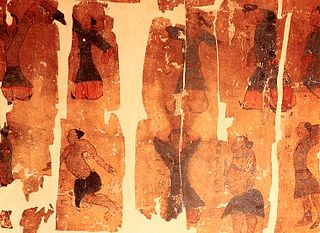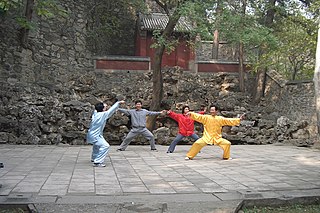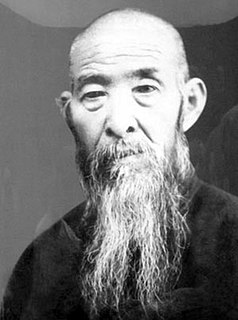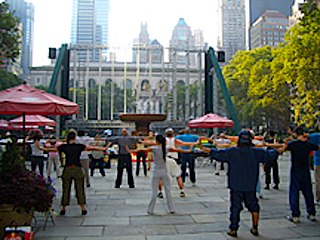
Neijia (内家) is a term in Chinese martial arts, grouping those styles that practice neijing, usually translated as internal martial arts, occupied with spiritual, mental or qi-related aspects, as opposed to an "external" approach focused on physiological aspects. The distinction dates to the 17th century, but its modern application is due to publications by Sun Lutang, dating to the period of 1915 to 1928. Neijing is developed by using neigong, or "internal exercises," as opposed to "external exercises",

Tai chi, short for T'ai chi ch'üan or Tàijí quán (太極拳), sometimes colloquially known as "Shadowboxing," is an internal Chinese martial art practiced for defense training, health benefits, and meditation.

Cheng Man-ch'ing or Zheng Manqing was a notable Chinese expert of t'ai chi ch'uan, Chinese medicine, and the so called three perfections: calligraphy, painting and poetry. He was born in Yongjia, Zhejiang Province, Republic of China (ROC). His birthday was on the 28th year of the Guangxu emperor's reign, 6th month, 25th day, which corresponds to July 29, 1902. Cheng died March 26, 1975; his grave is near the city of Taipei. Because of his skills in these five areas, considered among some of the traditional skills and pastimes of a Confucian scholar, he was often referred to as the "Master of Five Excellences." Because he had been a college professor, his students called him "Professor Cheng."

Daoyin is a series of body and mind unity exercises practiced as a form of Daoist neigong to cultivate jing (essence) and direct and refine qi, the internal energy of the body according to Traditional Chinese medicine. These exercises are often divided into yin positions, lying and sitting, and yang positions, standing and moving. The practice of daoyin was a precursor of qigong, and was practised in Chinese Taoist monasteries for health and spiritual cultivation. Daoyin is also said to be a primary formative ingredient in the well-known "soft styles" of the Chinese martial arts, of Taiji quan. and middle road styles like Wuxingheqidao.

Yang Chengfu or Yang Ch'eng-fu (1883–1936) is historically considered the best known teacher of the soft style martial art of Yang-style t'ai chi ch'uan.

Yang family-style T‘ai-Chi Ch‘üan (Taijiquan) in its many variations is the most popular and widely practised style in the world today and the second in terms of seniority among the primary five family styles of T'ai Chi Ch'uan.

The Chen family-style or Chen-style Taijiquan is a Northern Chinese martial art and the original form of Taiji. Chen-style is characterized by silk reeling, alternating fast and slow motions, and bursts of power.

103-form Yang family t'ai chi ch'uan, also called the Traditional Form, is a prescribed sequence of moves used to practice Yang-style t'ai chi ch'uan.

Sun Lu-t'ang or Sun Lutang (1860-1933) was a renowned master of Chinese neijia (internal) martial arts and was the progenitor of the syncretic art of Sun-style t'ai chi ch'uan. He was also considered an accomplished Neo-Confucian and Taoist scholar, and was a distinguished contributor to the theory of internal martial arts through his many published works.
The 42 Form t'ai chi ch'uan is the standard Wushu competition form which combines movements drawn from the Chen, Yang, Wu, and Sun styles of traditional T'ai chi ch'uan (Taijiquan). It was created in 1989 by Professors Men Hui Feng from The Beijing Sport Institute and Li De Yin from the People's University for the Chinese Sports Committee. The 42-form has been subjected to criticism for being a hybrid form, but in actual practice it has received a lot of positive attention as well, for being a challenging, fluid form which loads the body with energy (qi). Today it is a popular form for competition as well as for personal health benefits.
Fu Zhongwen (1903–1994) was a respected t'ai chi ch'uan teacher and author from China. From an early age, he had been a disciple of Yang Chengfu, and later a family member as he married Zou Kuei Cheng, the great-granddaughter of Yang Chien Hou.

Yang Shaohou was a Chinese martial arts master who, along with Yang Chengfu, represents the third generation of Yang-style t'ai chi ch'uan. Grandmaster of his generation and known for his compact "small frame" techniques, he was a ferocious fighter and a demanding teacher.

Single Whip is a common posture found in most forms of t'ai chi ch'uan. Typically at the end of the posture the left hand is in a palm outward push and the right hand held most commonly in the form of a hook or closed fist. Notable exceptions are the Single Whip in Sun-style and Wu/Hao style t'ai chi ch'uan which finish with both hands open, palms outward.
Fa jin, fajin or fa chin, sometimes misspelled as fajing, is a term used in some Chinese martial arts, particularly the neijia (internal) martial arts, such as xingyiquan, t'ai chi ch'uan (taijiquan), baguazhang, bak mei, and bajiquan.

The T'ai chi Classics, or Taijiquan Classics, is a collection of over 100 articles on the Chinese martial art of t'ai chi ch'uan written by the art's master practitioners over the centuries. They cover everything from the underlying Taiji philosophical principles, to methods of practice and application. Previously passed down in secret from generation to generation in whole or in parts through various lineages, they achieved classical status as they became public starting in the mid-1930s. Together they now serve as the single authoritative guide for the development and usage of Taijiquan skills. Written mostly in classical Chinese, they are used today mostly by the serious martial art practitioners of modern 6 Lineages that all trace their lineages to the ancient style taught by the Chen family and Yang family starting in the mid-19th century.
The different slow motion solo form training sequences of t'ai chi ch'uan are the best known manifestation of t'ai chi for the general public. In English, they are usually called the hand form or just the form; in Mandarin it is usually called ch'uan.

Qigong, qi gong, chi kung, or chi gung is a system of coordinated body-posture and movement, breathing, and meditation used for the purposes of health, spirituality, and martial-arts training. With roots in Chinese medicine, philosophy, and martial arts, qigong is traditionally viewed by the Chinese and throughout Asia as a practice to cultivate and balance qi, translated as "life energy".
Squatting is a versatile posture where the weight of the body is on the feet but the knees and hips are bent. In contrast, sitting involves taking the weight of the body, at least in part, on the buttocks against the ground or a horizontal object. The angle between the legs when squatting can vary from zero to widely splayed out, flexibility permitting. Another variable may be the degree of forward tilt of the upper body from the hips. Squatting may be either full or partial.

Tung Ying-chieh was a leading master of t'ai chi ch'uan, and a top disciple of Yang Ch'eng-fu. Born in Ren County, Hebei, China, his given name was Wen-k'e. Famous in his time for defeating a foreign boxer in a public challenge match, he dedicated his life to the martial arts, training intensively in multiple styles, serving as chief assistant instructor for Yang Ch'eng-fu, and going on to found his own thriving t'ai chi legacy.










